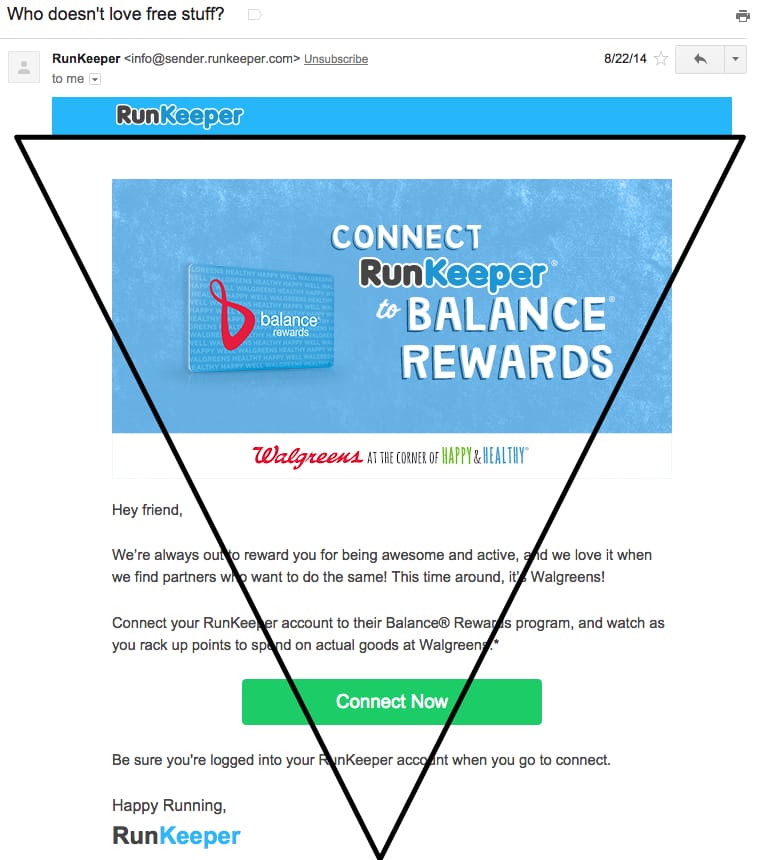
The Inverted Pyramid Method: How to Create Focused Emails That Really Convert
-
Messaging and AutomationUpdatedPosted:
On this page
The problem with copy, content and design is that they sometimes distract users from the goal. Great emails need focus. It’s the key to clicks, actions, purchases and engagement.
The Inverted Pyramid Method is a template designed to help you create great emails by eliminating distractions.

In this method, the entire email builds towards a call to action. By the time the reader gets there, they are eager to click. There is nothing else to do but click.
Editor’s note: Journalism students will recognize this as a common way to shape news stories. There is a key difference, however, in that journalists use the bottom of the triangle is for the least important information. In email, it’s just the opposite.
How to Send Focused Emails
Let’s start with an example of what NOT to do.
This email from Costco is one of the worst I’ve ever seen. I refuse to even embed it in this post.
Costco spent a lot of time designing this email. They spent a lot of time writing copy. They spent a lot of time jamming content into it.
But this email has no focus.
What am I supposed to do next? It’s anyone’s guess.
It’s an extreme example but it’s easy to fall into this trap. The Inverted Pyramid Method is an easy way to eliminate distractions. The result of Costco’s email is wasted money and time, and more importantly, a failure to build rapport with subscribers. I know that Costco emails are all noise and no signal so I don’t open them (unless I need an example of a bad email for a blog post).
Highly focused emails don’t rely on design, images or copy. They rely on tone, timing and clarity. And that creates a real advantage for businesses smart enough to send them.
Let’s take a look at what I mean.
Note: These are all examples of promotional email. It’s easy to send focused lifecycle emails and there are tons of examples of that here.
RunKeeper

This email is clearly promotional but it’s extremely clear what the user should do next. “Connect Now” … that’s it.
The copy in the email simply tees up the call the action. It never distracts the recipient from the goal.
Things for Mac

Here’s an example of an email that uses visual imagery as an aid rather than a distraction. The sketch simply shows what this new feature will look like, relieving the anxiety of something new. (Change is hard – never underestimate that in your marketing.)
Everything in this email leads the recipient – both intellectually and visually – to the blue button at the bottom.
Max Ogles

Max Ogles specializes in behavior technology so it’s not surprising to see him use this strategy. This email works because Max uses only a small amount of copy plus an image to set the tone for the essay.
When to Use the Inverted Pyramid Method
All the time.
Well, at least in every situation where action is imperative.
The Inverted Pyramid Method works beautifully in onboarding emails, welcome emails, lifecycle emails, behavioral emails and promotional emails.
It also pairs nicely with the 1-2-3 method, which is another way to structure emails for maximum impact.
Regardless of the layout, invest time in minimizing distractions and honing focus. It’s a surefire way to improve the effectiveness of every email you send.
Have any questions or thoughts on the Inverted Pyramid Method? Drop a note in the comments.
Want to send more personalized mobile and email messages to your users?
Learn moreCustomer story

How UNO uses email marketing from the data warehouse to deliver personalized mortgage broking

